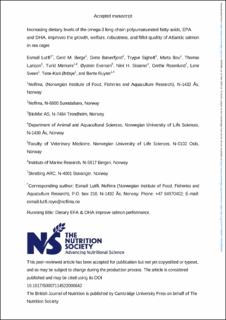| dc.contributor.author | Lutfi Royo, Esmail | |
| dc.contributor.author | Berge, Gerd Marit | |
| dc.contributor.author | Bæverfjord, Grete | |
| dc.contributor.author | Sigholt, Trygve | |
| dc.contributor.author | Bou, Marta | |
| dc.contributor.author | Larsson, Thomas | |
| dc.contributor.author | Mørkøre, Turid | |
| dc.contributor.author | Evensen, Øystein | |
| dc.contributor.author | Sissener, Nini | |
| dc.contributor.author | Rosenlund, Grethe | |
| dc.contributor.author | Sveen, Lene | |
| dc.contributor.author | Østbye, Tone-Kari K | |
| dc.contributor.author | Ruyter, Bente Synnøve | |
| dc.date.accessioned | 2022-03-24T12:27:28Z | |
| dc.date.available | 2022-03-24T12:27:28Z | |
| dc.date.created | 2022-03-22T13:37:24Z | |
| dc.date.issued | 2022 | |
| dc.identifier.citation | British Journal of Nutrition. 2022, 1-48. | |
| dc.identifier.issn | 0007-1145 | |
| dc.identifier.uri | https://hdl.handle.net/11250/2987362 | |
| dc.description.abstract | The present study evaluated the effects of increasing the dietary levels of eicosapentaenoic acid (EPA) and docosahexaenoic acid (DHA) in Atlantic salmon (Salmo salar) reared in sea cages, in terms of growth performance, welfare, robustness, and overall quality. Fish with an average starting weight of 275 g were fed one of four different diets containing 10, 13, 16, and 35 g/kg of EPA and DHA (designated as 1.0%, 1.3%, 1.6%, and 3.5% EPA and DHA) until they reached approximately 5 kg. The 3.5% EPA and DHA diet showed a significantly beneficial effect on growth performance and fillet quality compared with all other diets, particularly the 1% EPA and DHA diet. Fish fed the diet containing 3.5% EPA and DHA showed 400-600 g higher final weights, improved internal organ health scores and external welfare indicators, better fillet quality in terms of higher visual colour score and lower occurrence of dark spots, and higher EPA and DHA content in tissues at the end of the feeding trial. Moreover, fish fed the 3.5% EPA and DHA diet showed lower mortality during a naturally occurring cardiomyopathy syndrome outbreak, although this did not reach statistical significance. Altogether, our findings emphasise the importance of dietary EPA and DHA to maintain good growth, robustness, welfare, and fillet quality of Atlantic salmon reared in sea cages. | |
| dc.language.iso | eng | |
| dc.title | Increasing dietary levels of the omega-3 long-chain polyunsaturated fatty acids, EPA and DHA, improves the growth, welfare, robustness, and fillet quality of Atlantic salmon in sea cages | |
| dc.type | Peer reviewed | |
| dc.type | Journal article | |
| dc.description.version | acceptedVersion | |
| dc.source.pagenumber | 1-48 | |
| dc.source.journal | British Journal of Nutrition | |
| dc.identifier.doi | 10.1017/S0007114522000642 | |
| dc.identifier.cristin | 2011719 | |
| dc.relation.project | Norges forskningsråd: 273202 | |
| dc.relation.project | Fiskeri- og havbruksnæringens forskningsfinansiering: 901487 | |
| dc.relation.project | Fiskeri- og havbruksnæringens forskningsfinansiering: 901282 | |
| cristin.ispublished | true | |
| cristin.fulltext | postprint | |
| cristin.qualitycode | 2 | |
